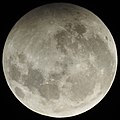January 2020 lunar eclipse
Appearance
This article includes a list of general references, but it lacks sufficient corresponding inline citations. (December 2020) |
| Penumbral eclipse | |||||||||
 Near greatest eclipse in Austria, 19:10 UT | |||||||||
| Date | 10 January 2020 | ||||||||
|---|---|---|---|---|---|---|---|---|---|
| Gamma | 1.0726 | ||||||||
| Magnitude | 0.8956 | ||||||||
| Saros cycle | 114 (16 of 71) | ||||||||
| Penumbral | 244 minutes, 34 seconds | ||||||||
| |||||||||
A penumbral lunar eclipse took place on 10 January 2020. It was the first of four penumbral lunar eclipses in 2020. The moon’s apparent diameter was larger than average because occurred only 3 days before perigee (Perigee on 13 January 2020) and its distance was 375,887 km (233,565 mi).
Visibility
 
|
 Visibility map |
Gallery
-
Oria, Italy, 18:09 UTC
-
San Jose del Monte, Philippines, 18:47 UTC
-
Colombo, Sri Lanka, 19:03 UTC
-
Ham, Belgium, 19:08 UTC
-
Pamplona, Spain, 20:19 UTC
-
Eclipse sequence from Austria, 18:10–20:10 UTC
Related eclipses
Eclipses of 2020
- A penumbral lunar eclipse on 10 January.
- A penumbral lunar eclipse on 5 June.
- An annular solar eclipse on 21 June.
- A penumbral lunar eclipse on 5 July.
- A penumbral lunar eclipse on 30 November.
- A total solar eclipse on 14 December.
Tzolkinex
- Preceded: Lunar eclipse of 28 November 2012
- Followed: Lunar eclipse of 20 February 2027
Half-Saros cycle
- Preceded: Solar eclipse of 4 January 2011
- Followed: Solar eclipse of 14 January 2029
Tritos
- Preceded: Lunar eclipse of 9 February 2009
- Followed: Lunar eclipse of 9 December 2030
Lunar Saros 144
- Preceded: Lunar eclipse of 30 December 2001
- Followed: Lunar eclipse of 21 January 2038
Inex
- Preceded: Lunar eclipse of 30 January 1991
- Followed: Lunar eclipse of 20 December 2048
Triad
- Preceded: Lunar eclipse of 12 March 1933
- Followed: Lunar eclipse of 11 November 2106
Lunar year series
| Lunar eclipse series sets from 2016–2020 | ||||||||
|---|---|---|---|---|---|---|---|---|
| Descending node | Ascending node | |||||||
| Saros | Date | Type Viewing |
Gamma | Saros | Date Viewing |
Type Chart |
Gamma | |
| 109 | 2016 Aug 18
|
Penumbral
|
1.56406 | 114
|
2017 Feb 11
|
Penumbral
|
−1.02548 | |
119
|
2017 Aug 07
|
Partial
|
0.86690 | 124
|
2018 Jan 31
|
Total
|
−0.30143 | |
129
|
2018 Jul 27
|
Total
|
0.11681 | 134
|
2019 Jan 21
|
Total
|
0.36842 | |
139
|
2019 Jul 16
|
Partial
|
−0.64300 | 144
|
2020 Jan 10
|
Penumbral
|
1.07270 | |
| 149 | 2020 Jul 05
|
Penumbral
|
−1.36387 | |||||
| Last set | 2016 Sep 16 | Last set | 2016 Mar 23 | |||||
| Next set | 2020 Jun 05 | Next set | 2020 Nov 30 | |||||
Saros series
It is part of Saros cycle 144.
Half-Saros cycle
A lunar eclipse will be preceded and followed by solar eclipses by 9 years and 5.5 days (a half saros).[1] This lunar eclipse is related to two partial solar eclipses of Solar Saros 151.
| 4 January 2011 | 14 January 2029 |
|---|---|

|

|
See also
References
- ^ Mathematical Astronomy Morsels, Jean Meeus, p.110, Chapter 18, The half-saros









